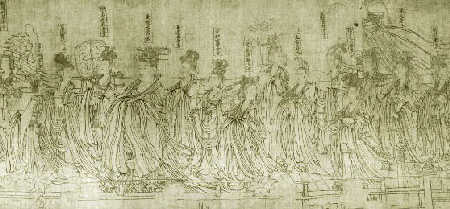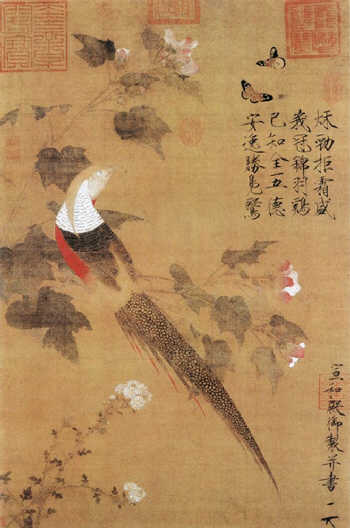Imperial painting academies were first established in the Five Dynasties. They were under the direct administration of the imperial government. Painters of the academies enjoyed the same treatment as literary officials in courts, wore official suits, and received salaries from the imperial government. The academies gathered the most excellent painters in the country. Their tasks were to draw portraits for the nobles, and when important social events occurred, they were required to record them in paintings. These activities helped to improve the skills of the painters. Well-known painters during this period include the flower and bird painters, Huang Quan and Huang Jucai of the Shu State (908-925) and the portrait painters Cao Zhongxuan, Zhou Wenju and Gu Hong of the Southern Tang State (947-958). They were responsible for great artistic achievements and strongly influenced their successors.

By Wu Zongyuan, Song Dynasty
The Song Dynasty united China again in 960 and expanded the imperial painting academy. All the great painters from the Five Dynasties applied for posts in the Song Dynasty Imperial Painting Academy, and it became the creative center of painting of the time. The abbot of the Zhaoying Palace of the YuqingTempleselected painters to draw murals on the palace wall; over 3,000 painters came for the selection examination and about 100 were chosen, including Wu Zongyuan, whose works were considered as good asWu Daozi's. Zhang Zeduan, painter of theQingming Festival by the Riverside, also served in the Imperial Painting Academy.
The Imperial Painting Academy reached its peak of development in the period from Emperor Huizong's reign to Emperor Xiaozong's reign of theSouthern Song Dynasty(1127-1279). The entry examination for the painting academy was included in the imperial civil service examination system.
The painting examination contained six subjects, including drawing pictures based on ancient poems. Some painters chose unique angles to reveal the meaning of the poems. For example, in drawing the concept for the line "No body comes across the wild river, A single boat stays on the river", one painter portrayed a boatman asleep at one end of the boat with a flute beside him, indicating he had had no customers the whole day and felt very tired. In another examination, for the line "An ancient temple hides in the deep mountain", a painter drew a young monk fetching water from a stream.
The flourishing of the painting academy in the Song Dynasty was largely due to Emperor Huizong's interest in painting andcalligraphy. Emperor Huizong, whose name wasZhao Ji, was the initiator and an active supporter of the academy, and also a painter and connoisseur of painting. He required his painters to draw inspiration from nature and grasp both the subject's image and inner world. Once Zhao asked the painters to draw a peacock spreading its tail, but he was not satisfied with their works. When they asked why, he explained that the peacock usually raises its left foot first when it spreads its tail, but all the painters had the peacock's right foot raised.

Hibiscus and Golden Pheasantby Zhao Ji
Zhao not only paid attention to painting sketches, but also the physical aspects of the paintings. He once drew 20 different gestures of a crane. When he drew birds, he liked to use lacquer to highlight their eyes to make them stand out from thepaperand appear brighter and more prominent. He achieved much in portraiture and in paintings of mountains, rivers, flowers and birds, but was best known for his flower and bird paintings. Representative works with his signature includeWild Birds on Wild Prunus,Hibiscus and Golden PheasantandCranes. Because of his special social position, some works with his signature might have been drawn by his imperial painters. Another of Zhao Ji's important achievements was that he created the shoujin (slender gold) style of calligraphy. He also played an active role in collecting and classifying art heritages, and he suggested editing several ancient calligraphy and painting books.
Zhao Ji was a foolish emperor in Chinese history who caused the collapse of the Song Dynasty, but he did made great contributions to the development of Chinese art. He was not a good politician but a fine artist.










